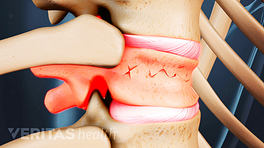The first step in preventing osteoporosis and associated spine fractures is to determine whether you are at risk or high risk for developing the bone condition. Different physical characteristics and lifestyle choices can contribute to osteoporosis in both men and women.
Risk factors for osteoporosis1 include:
- Advanced age. Those over 65 years of age are at particular risk.
- Gender. Women are at much greater risk, losing bone more rapidly than men due to menopause. However, men are also at risk and constitute 20% of the patient population with osteoporosis.
- Family and personal history. This includes family history of osteoporosis, history of fracture on the mother’s side of the family, and a personal history of any kind of bone fracture as an adult (after age 50).
- Race. Caucasian and Asian women are at increased risk.
- Body type. At greater risk are small-boned women who weigh less than 127 pounds.
- Menstrual history and menopause. Normal menopause alone increases a woman’s risk of osteoporosis. Early menopause or cessation of menstruation before menopause increases the risk even more.
- (Males) Hypogonadism. This condition is also knows as testosterone deficiency.
- Lifestyle. Lifestyle behaviors that increase osteoporosis risk include: calcium and/or vitamin D deficiency; little or no exercise, especially weight-bearing exercise; alcohol abuse; cigarette smoking.
- Chronic diseases and medications. Certain types of medications can damage bone and lead to what is termed “secondary osteoporosis”. This type of osteoporosis is estimated to occur in almost 50% of pre-menopausal women with osteoporosis and from 30% to 60% of men with osteoporosis. Also, secondary osteoporosis can cause further bone loss in postmenopausal women and older men with primary osteoporosis2. Included in this category are certain medications to treat endocrine disorders such as hyperthyroidism, marrow disorders, collagen disorders, gastrointestinal problems and seizure disorders. Use of glucocorticoids (steroids) to treat diseases such as asthma, rheumatoid arthritis and inflammatory bowel disease, especially the oral form of these medications (at higher doses and over longer periods of time e.g., more than 2 months), can be particularly damaging to bone. Given the serious nature of the diseases these medications treat, it is not advisable to alter or stop taking these drugs unless under a physician’s advice.
People considered at especially high risk for developing osteoporosis include:
- All women over age 65.
- Women less than age 65 who are postmenopausal and have one or more of the above described risk factors for osteoporosis.
- Postmenopausal women who experience any type of bone fracture.
- Men who have a testosterone deficiency.
For those with any of the above risk factors for osteoporosis, it is advisable to get a bone density test to assess bone mass and the presence of osteoporosis. Knowledge of one’s bone density is vital to developing an appropriate action plan to prevent worsening of the condition and hopefully prevent a painful osteoporosis-related fracture.
See Signs and Complications of Osteoporosis
References
- 1.National Osteoporosis Foundation – Prevention, Prevalence. www.nof.org. Accessed 5/19/06.
- 2.The NIH Osteoporosis and Related Bone Diseases ~ National Resource Center. "Secondary Osteoporosis", Volume 4, Number 1, December 2001. http://www.niams.nih.gov/Health_Info/Bone/...Accessed 7/11/06.






